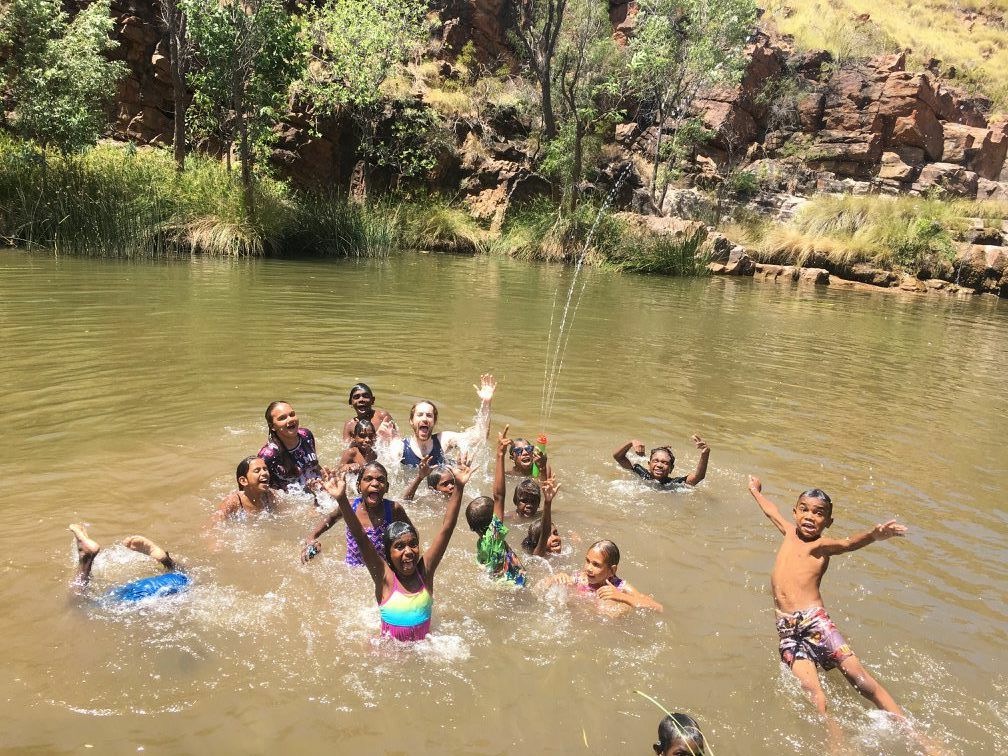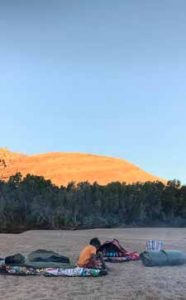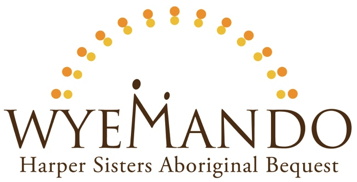Jiyagbinggbirri Gooniyandi (Speaking Gooniyandi) 2017
![]()
On-country language and cultural learning for the children of Yiyili
Yiyili Community Aboriginal School
Yiyili Community, East Kimberley
March to December 2017

Jiyagbinggbirri Gooniyandi offered the children of Yiyili Aboriginal Community School recurring on-country learning over the course of 2017. Each child in the school, from Kindergarten to Year 10, had opportunity to spend an average of two days per term on bush trips. The trips were accompanied by community members, including those with the appropriate Gooniyandi language and cultural expertise to guide the children in their learning. This on-country learning was complemented by in-class learning before and after trips.
In Term One the wet season limited outings to nearby destinations and single day trips. In Term Two and Three, overnight trips became possible, enabling travel further afield. These camping trips allowed the time for connecting with the environment, hearing stories from elders around the fire and gaining Gooniyandi language and cultural knowledge. In Term Four, soaring temperatures again meant most trips were single day excursions to a ‘living spring’ where the water stays fresh all year, an area of deep cultural significance.
 |
 |
 |
Why are these trips important?
There are estimated to be less than 100 Gooniyandi speakers remaining. Kriol, the contact language of the Kimberley region, is most commonly used in Yiyili and is the first language for most Yiyili children. Many Gooniyandi words remain in use within Kriol but Gooniyandi is seldom spoken in its own right. This project is part of a greater objective within the school and the community to move from use of single Gooniyandi words to using “meaningful chunks of text” in everyday life.
The learning environment is also important to the community. Yiyili community sits on Gooniyandi homelands and the community are passionate about ensuring their children are regularly taken out to places that are special to Gooniyandi people. They want their children to continue to listen to and speak their language and learn cultural knowledge in the most meaningful context: the country it relates to.
The community school offers an ideal forum for the trips, providing coordination, vehicles, supervision and in-school learning support. Wyemando funding covered the cost of fuel and food for the trips, which can be a barrier for communities wanting to access bush trips and pass down cultural knowledge on-country.
Activity Goals
The trips aimed to:
- increase understanding of Gooniyandi language among the children
- increase the use of Gooniyandi language at home and at school
- grow strong cultural identity for the children
- increase school attendance
- increase community engagement with the school
- grow a bank of photographic and video language resources to support ongoing language learning
Activity Outcomes
The bush trips have helped reinvigorate the school’s Gooniyandi language and culture program. They have provided plenty of opportunity for Gooniyandi language to be used in context and rich experiences for the Gooniyandi teachers to bring back to the classroom.
Students’ single word Gooniyandi vocabularly grown. Most have begun singing songs and saying a few catchy little phrases of Gooniyandi. This was further stimulated by the Indigenous Hip Hop Project that came to school in Term Two to produce its first ever all Aboriginal language hip hop song Yiyili Mawilyi (Yiyili Kids). The kids now hear Yiyili Mawilyi and sing along twice daily when it’s played right through over the PA after each play break as the return-to-class signal.
For older students an attendance requirement was built in to participation on bush trips and there was a steady rise in school attendance as the year progressed and the children realised this was non-negotiable.The bush trips with elders and children fed into the teachers’ growing confidence in their knowledge of Gooniyandi language and culture. Both have subsequently enrolled in a teacher training course with other Aboriginal language teachers.Each trip had two or more people beyond school staff accompanying the children. This was a great way for new school staff to get to know the extended family of their students. This has developed relationships with the teachers and these family members have felt less shy about visiting the classroom for other occasions.
![]()
